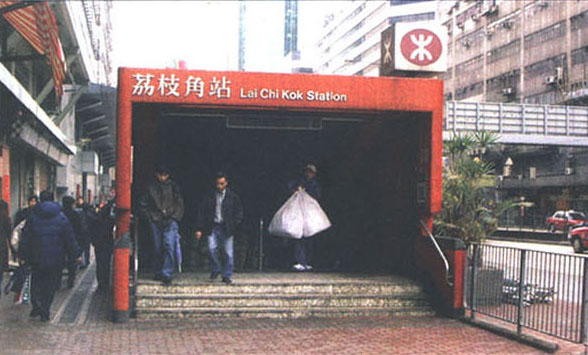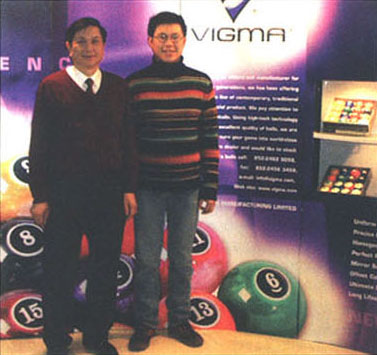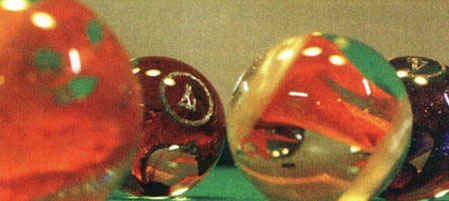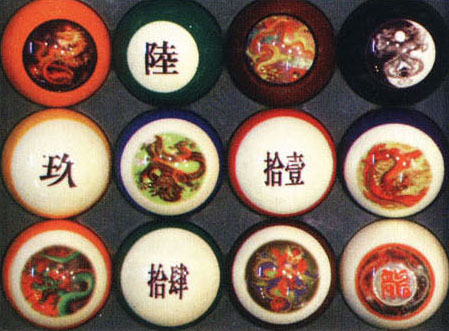


Fig.6 (left): Hong Kong's Lai Chi Kok metro statkion lies in an industrial section one block from Vigma.
Fig.7 (right): Stanley Ng (right), Vigma's business development manager, and his father, H.C.Ng, are from a long line of plastics manufacturers.Hong Kong's Lai Chi Kok metro statkion lies in an industrial section one block from Vigma.
 |
 |
Fig. 8 (top): Vigma's Shangri-La set seems other-worldy in this table's-eye view. |
Fig. 9 (bottom) : The Dragons set has numerals in Chinese characters. |
************************************************ |
The ball industry is now quite small, with only a few manufacturers remaining. So I was surprised a year ago to see an ad for a new one. Vigma Balls Manufacturing Limited, in Billiard Digest.I had never heard of that brand, and became more interested when I found that their main office was in Hong Kong, in an industrial area of Kowloon called Lai Chi Kok (Fig.6). Snooker is the primary game in Hong Kong, and though pool is increasing in popularity, it has never been known as a center for billiard supplies. I visit Hong Kong annually for other reasons, so earlier this year I got in touch with the company to see if I could arrange a visit. |
|
My host was Vigma's business development manager Stanley Ng. The Hong Kong location is not a factory, but a showroom and marketing office. The manufacturing plant is in Guangshou (formerly Canton) on the Chinese mainland about 80 miles northwest of Hong Kong. |
|
The company, despite the unfamiliarity of its name, is not a new comer to billiards. It has been making balls for 60 years under the leadership of Stanley's father, H.C.Ng (Fig.8). For decades it has supplied balls to famous companies who resell them as their own brands. You would probably be shocked to learn that you've probably played with Vigma balls without knowing it. This idea aroused my journalislic interest, but Stanley was the picture of discretion and politely declined to tell me the name of even one of his customers. |
|
In 2003. Vigma decided to launch a line of balls under its own name that wasn ot competitive with its private labels. They wanted a new look, new composition, and a low price but a high level of quality, because of tis long history of experimentation with plastics, Vigma was able to develop a line of formulations ranging from opaque to semi-transparent (Fig.8). The basic material of Vigma balls is Kobo resin, a hard and scratch-resistant compound developed by the elder Mr. Ng, who has spent a lifetime in the plastics business and owns an affiliate that is the largest manufacturer of plastic suction cups in the world. Banish any idea you might have that Chinese balls are inferior, for quality is a mania at Vigma. According to Billiard Congress of America standards, the weight of a pool ball is allowed to vary anywhere from 5-1/2 to 6 ounces. There is no standard at all for weight variance within a whole set. In other words, it's acceptale for the 8 ball to weight 5-1/2 ounces and the 9 ball to be half an ounce heavier. Not at Vigma. The maximum weight variance allowed between the lightest and heaviest balls in a full set is 1.6 grams, or 1/8 of an ounce, nine times the precision required by the BCA. Industry specifications require the diameter of a ball not to vary by more than 5/1000th of an inch in any direction. Vigma maintins a tolerance of 4/10,000th of an inch, more than 10 times as accurate. Each set is finished together as a unit to assure consistency. Possibly the most striking feature of Vigma's product line is its ability to apply arbitrary graphics to billiard balls at very low cost. It used a trade secret process based on heat-transfer dyes. The image is not applied to the surface of the ball, where it would eventually rub off even with a coatingm, but it actually molded as part of the ball at 175 lines per inch resolution, which yields the same quality as photo offset. Vigma produces a wide variety of stock ball set with vivid designs. One of my favorites, the Dragons set, is shown in Fig.9. Each ball has a dragon image and the Chinese characters represent numbers. If you don't know Chinese, you can recognize the balls from their familiar colors. The nature of the production process is that completely customized sets of balls can be made in low quantities at low cost, often not much more than a stock set. It is possible to order a single set of customized balls with your own graphic just by supplying the digital image you want on the ball. |